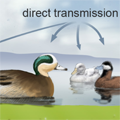Abstract
Avian Influenza Viruses (AIVs) have been pivotal to the origination of human pandemic strains. Despite their scientific and public health significance, however, there remains much to be understood about the ecology and evolution of AIVs in wild birds, where major pools of genetic diversity are generated and maintained. Here, we present comparative phylodynamic analyses of human and avian influenza viruses in North America, demonstrating (i) significantly higher standing genetic diversity and (ii) phylogenetic trees with a weaker signature of immune escape in AIVs than in human viruses. To explain these differences, we performed statistical analyses to quantify the relative contribution of several potential explanations. We found that HA genetic diversity in avian viruses is determined by a combination of factors, predominantly subtype-specific differences in host immune selective pressure and the ecology of transmission (in particular, the durability of subtypes in aquatic environments). Extending this analysis using a computational model demonstrated that virus durability leads to long-term, indirect chains of transmission that, when coupled with a short host life-span, can generate and maintain the observed high levels of genetic diversity. Further evidence in support of this novel finding was found by demonstrating an association between subtype-specific environmental durability and predicted phylogenetic signatures: genetic diversity, variation in phylogenetic tree branch lengths and tree height. The conclusion that environmental transmission plays an important role in the evolutionary biology of avian influenza viruses – a manifestation of the “storage effect’’ – highlights the potentially unpredictable impact of wildlife reservoirs for future human pandemics and the need for improved understanding of the natural ecology of these viruses.
